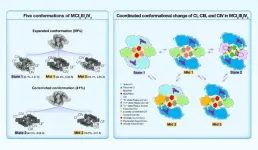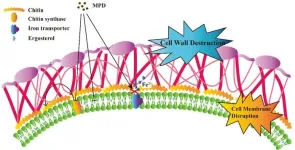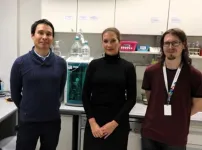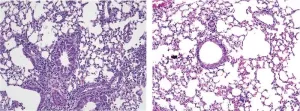A global map of how climate change is changing winegrowing regions
2024-03-26
(Press-News.org)
Grapes grown to make wine are sensitive to climate conditions such as temperature and extreme drought. These effects are already visible worldwide on yields, the composition of grapes and the quality of wines, with already and soon-to-be-observed consequences on the geography of wine production. Understanding shifts in wine production potential due to climate change is a major scientific concern. Based on their expertise and a thorough analysis of the scientific literature — over 250 publications in the last 20 years – a research team has established a global map of evolving trends in the threats and potential benefits that climate change brings to existing and new winegrowing regions. They did so by studying the effects of changes in temperature, rainfall, humidity, radiation and CO2 on wine production and exploring adaptation strategies.
Climate winners, climate losers
Winegrowing regions are primarily located at mid-latitudes where the climate is warm enough to allow grape ripening, but without excessive heat, and relatively dry to avoid strong fungal disease pressure. Rises in temperature – one of the most emblematic symptoms of climate change – accelerate vine development and the early ripening of grapes during the hottest periods in the summer. Harvesting in most vineyards now begins two to three weeks earlier than it did 40 years ago, with effects on grapes and the resulting styles of wines. Temperature increases, for example, can change how a wine tastes if grapes lose acidity, increase wine alcohol, and modify aromatic signatures. On a global scale, climate change could reduce growable surface area in current wine regions and increase it in others.
If global warming exceeds 2°C, some 90% of all traditional winegrowing areas in the coastal and plains regions of Spain, Italy, Greece and southern California may become unable to produce high-quality wine in economically sustainable conditions by the end of the century due to risks of excessive drought and more frequent heat waves. Conversely, higher temperatures could improve the suitability of other regions for the production of quality wines, including northern France, the states of Washington and Oregon in the United States, the province of British Columbia in Canada and Tasmania in Australia. They could even create new wine regions, in Belgium, Netherlands and Denmark.
The emergence of new diseases and pests, as well as an increase in the frequency of extreme events, are other upcoming challenges for producers. Vineyards can withstand global warming below the 2°C limit by using more drought-resistant grape varieties and rootstocks and by adopting management methods that better preserve soil water, such as decreasing vineyard density and protecting against erosion, as demonstrated by several studies conducted in partnership with winegrowers[1]. Adaptation strategies also depend heavily on local conditions and are only worthwhile if they can ensure the economic viability of production. Producers in higher latitudes, on the other hand, may see their yields and the quality of their wine increase thanks to rising temperatures.
This study confirms the heightened threat that climate change poses to the quality of wines produced in traditional vineyards. It also confirms the key 2°C limit beyond which global warming will make major changes necessary in wine production worldwide.
[1] See the results of the LACCAVE research partnership on measures to adapt viticulture to climate change https://www.inrae.fr/en/news/laccave-ten-year-research-partnership-adapt-viticulture-climate-change
These results are also available in a book (in French): https://www.inrae.fr/actualites/vigne-vin-changement-climatique
END
[Attachments] See images for this press release:

ELSE PRESS RELEASES FROM THIS DATE:
2024-03-26
SAN ANTONIO — March 26, 2024 —Southwest Research Institute Senior Research Scientist Dr. Rohini Giles has received the NASA Early Career Achievement Medal. The medal recognizes unusual and significant performance supporting NASA’s mission during the first 10 years of their career. Giles was cited for “significant early career achievements in the analysis of Juno data to study Jovian Transient Luminous Events and the distribution of constituents in Jupiter’s atmosphere.”
“It’s ...
2024-03-26
About The Study: In this cohort study of 64,000 low-income Americans, nearly 80% of study participants consumed sodium exceeding the current recommended daily amount, which was associated with 10% to 30% of cardiovascular disease mortality. Public health programs targeted to reduce sodium intake among this underserved population may be beneficial.
Authors: Xiao-Ou Shu, M.D., Ph.D., of the Vanderbilt University School of Medicine in Nashville, is the corresponding author.
To access the embargoed study: Visit our For The Media website at this link https://media.jamanetwork.com/
(doi: 10.1001/jamanetworkopen.2024.3802)
Editor’s Note: Please see the ...
2024-03-26
About The Study: In this cohort study including 309,000 Danish children, longer duration of exclusive breastfeeding was associated with reduced risk of childhood B-cell precursor-acute lymphoblastic leukemia, corroborating results of previous case-control investigations in this field. To inform future preemptive interventions, continued research should focus on the potential biologic mechanisms underlying the observed association.
Authors: Signe Holst Søegaard, Ph.D., of the Danish Cancer Society in Copenhagen, is the corresponding ...
2024-03-26
There are 40% more Hispanic/Latino kids diagnosed with acute lymphoblastic leukemia (ALL) than white non-Hispanic/Latino children; actually, Hispanic/Latino individuals have the highest risk of ALL in the United States. However, the basis for this difference is not well understood. Researchers recently identified a genetic variant that accounts for the increased risk of B-cell ALL in Hispanic/Latino children, and using ancient DNA, they traced the mutation all the way back to the first migrants who ...
2024-03-26
Acute lymphoblastic leukemia (ALL), the most common childhood cancer, disproportionately affects children of Hispanic/Latino origin in the United States. They are 30-40% more likely to get ALL than non-Hispanic white children, but the exact genetic basis and cause of that increased risk are unknown.
Now, a study from the Keck School of Medicine of USC has revealed a key genetic variant contributing towards the increased risk, as well as details about the biological basis of ALL. The team used genetic fine-mapping analysis, a statistical method that allows researchers ...
2024-03-26
Mammalian mitochondrial electron transport chain complexes are the most important and complicated protein machinery in mitochondria. Although this system has been studied for more than a century, its composition and molecular mechanism are still largely unknown. Here, Yang’s group report the high-resolution cryo-electron microscopy (cryo-EM) structures of porcine respiratory chain megacomplex-I2III2IV2 (MCI2III2IV2) in five different conformations, including State 1, State 2, Mid 1, Mid 2, and Mid 3. High-resolution cryo-EM imaging, combined with super-resolution gated stimulated emission depletion microscopy (gSTED), strongly supports ...
2024-03-26
This study is led by Prof. Ying Li (Xuzhou Medical University), Prof. Zuobin Zhu (Xuzhou Medical University), and Prof. Wenqiang Chang (Shandong University). A small molecule library consisting of 40 compounds, specifically N-substituted maleimide and its derivatives were initially screened in the study. Among them, twelve maleimides, each with a distinct N-protection group, were synthesized using ring-opening and ring-closing reactions involving various amines and maleic anhydride. Additionally, a set of twenty-eight ...
2024-03-26
Researchers from the University of Tartu and the University of Copenhagen have proposed the theoretical description of an ideal electrocatalysis process, which, if implemented, could double the efficiency of energy conversion and storage devices.
As the world seeks sustainable solutions to meet escalating energy demands, a collaborative team of researchers from the Universities of Tartu and Copenhagen has proposed an innovative approach to overcome long-standing limitations in oxygen electrocatalysis. Oxygen electrocatalysis ...
2024-03-26
Researchers at the Keck School of Medicine, University of Southern California, have discovered that a protein called Piezo1 prevents a type of immune cell in the lung from becoming hyperactivated by allergens. The study, to be published March 26 in the Journal of Experimental Medicine (JEM), suggests that switching on Piezo1 could represent a new therapeutic approach to reducing lung inflammation and treating allergic asthma.
Type 2 innate lymphoid cells (also known as ILC2s) are a type of immune cell that resides in the lungs, skin, and other tissues of the body. ILC2s in the lungs become activated in the presence of allergens and produce ...
2024-03-26
Cardiac computed tomography angiography (CCTA or CTA) has emerged as a first-line tool for diagnosing, treating, and evaluating the prognosis of various cardiac diseases. In this special issue of JSCAI, "The Role of Cardiac Computed Tomography Angiography in Diagnosis, Treatment, and Prognosis of Cardiac Disease", experts detail the broad spectrum of uses of this imaging modality, acknowledging the role of this test in current clinical and procedural practice, including:
Risk stratification
Ruling out coronary artery disease in patients with chest pain
Assessing ...
LAST 30 PRESS RELEASES:
[Press-News.org] A global map of how climate change is changing winegrowing regions





